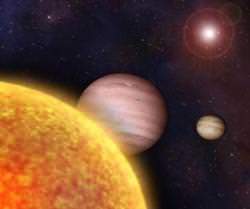As the search for extrasolar planets continues, researchers are finding systems more and more like our own Solar System. And today researchers announced another significant find: a system with two planets smaller than Jupiter and Saturn. It’s almost starting to sound like home.
The report, due to be published in the February 15th edition of the journal Science discusses a series of observations made back on March 28, 2006. An experiment, known as the Optical Gravitational Microlensing Equipment (OGLE), detected the telltale signal of a microlensing event on a star 5,000 light-years away.
In case you weren’t up in the latest techniques for planetary discovery, a lensing event happens when two stars line up perfectly in the sky from our perspective on Earth. The closer star acts as a natural lens, magnifying the light from the more distant star.
The curve of light coming from the event is very specific, and astronomers know when they’re seeing a microlensing event, compared to something else like a nova or a variable star.
But there are special situations, where the light from the star brightens normally, but then has an additional distortion. The gravity from planets orbiting the closer star can actually create this additional distortion. And from this, astronomers can calculate their size (amazing!). Only 4 planets had been discovered this way so far.
Okay, enough back story.
The OGLE group announced their potential lensing event, and astronomers around the world sprung into action, gathering data for the entire time that the stars were lined up.
Researchers first calculated that there was a Saturn-sized planet orbiting the star, and then another group found that there had to be a Jupiter-sized planet as well.
“Even though we observed the micolensing effect of the Saturn for less than 0.3 percent of its orbit, the observations simply could not be explained without accounting for the orbit,�? said David Bennett, a research associate professor of astrophysics from the University of Notre Dame.
Unfortunately, viewing this planetary system was a one-time event. We’ll probably never see this star line up again, so there’s no way to perform any followup observations.
Original Source: University of Notre Dame News Release


Hope they TIVO’d it.
oh well , tecnology may well advantage further still and enable us to learn more about this distant and small solar system which apparently mirrors ours
The sun is unremarkable. As far as planetary systems go, I’m sure we’ll be discovering many that have a similar makeup. Gas giants are obviously ubiquitous, and in our system, the rocky planets are at least as numerous so it follows (if a pattern can be found in 1) that we’ll find the accompanying rockies in due course. I’m looking forward to Rocky VI myself.
It’s probably on Youtube already…………………
one galaxy to another ” hey, I think that little planet way over there is (OGLE)ing me in an untoward manner.”